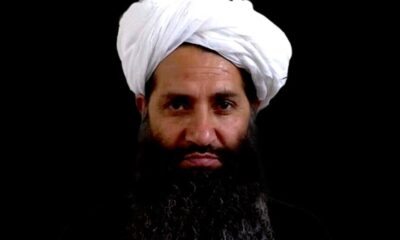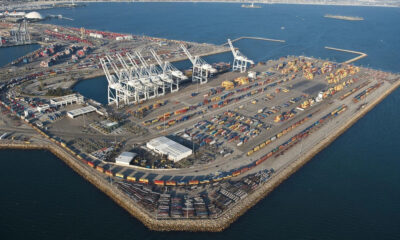World
Lebanon front with Israel heats up, stoking fears of wider war
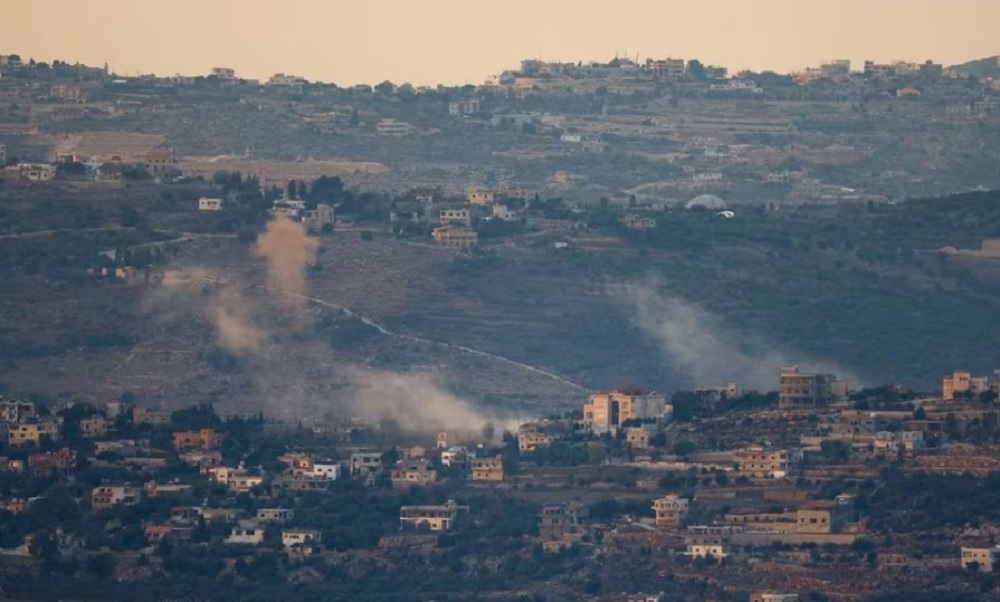
Weeks of hostilities across the Lebanese-Israeli border have escalated, with growing casualties on both sides and a war of words fuelling concerns of a widening conflict between Israel and the Iran-backed Lebanese group Hezbollah.
Israeli strikes killed two people in south Lebanon on Monday, according to a first-responder organization affiliated to the Hezbollah-allied Amal Movement.
On the Israeli side, a Hezbollah missile attack on Sunday wounded several workers from the Israel Electric Company and one died of his wounds on Monday, the firm said.
Hezbollah has been trading fire with Israeli forces since its Palestinian ally Hamas went to war with Israel on Oct. 7. Reuters reported.
The exchanges mark the deadliest violence at the border since Israel and Hezbollah fought a month-long war in 2006. So far, more than 70 Hezbollah fighters and 10 civilians have been killed in Lebanon, and 10 people including seven troops have been killed in Israel. Thousands more on both sides have fled shelling.
Until now, violence has largely been confined within a band of territory on either side of the border.
Israel has said it does not want war on its northern front as it seeks to crush Hamas in the Gaza Strip, while sources familiar with Hezbollah’s thinking said its attacks have been designed to keep Israel forces busy while avoiding all-out war.
The United States has said it doesn’t want conflict to spread around the region, sending two aircraft carriers to the area to deter Iran from getting involved. But that has not stopped the escalating rhetoric from Hezbollah and Israel.
Hezbollah leader Sayyed Hassan Nasrallah said on Saturday the Lebanon front would “remain active”, and said there was “a quantitative improvement” in the pace of the group’s operations.
Israeli Prime Minister Benjamin Netanyahu warned Hezbollah on Monday not to broaden its attacks.
“This is playing with fire. Fire will be answered with much stronger fire. They should not try us, because we have only shown a little of our strength,” he said in a statement.
Asked at a news conference on Saturday about what Israel’s red line was, Israeli Defence Minister Yoav Gallant said: “If you hear that we have attacked Beirut, you will understand that Nasrallah has crossed that line.”
Lebanon’s caretaker Prime Minister Najib Mikati, in an interview with Al Jazeera on Sunday, said he was reassured by the “rationalism” of Hezbollah so far.
“We are preserving self-restraint, and it’s up to Israel to stop its ongoing provocations in south Lebanon,” he said.
Lebanon took years to rebuild from the 2006 war and can ill afford another one, four years into a financial crisis that has impoverished many Lebanese and paralyzed the state.
Israel has long seen Hezbollah as the biggest threat along its borders. The 2006 war killed 1,200 people in Lebanon, mostly civilians, and 157 Israelis, mostly soldiers.
U.S. Defense Secretary Lloyd Austin characterized the violence as “tit-for-tat exchanges between Lebanese Hezbollah and Israeli forces in the north”, predicting Israel would remain focused on the threat from Hezbollah “for the foreseeable future”.
“And certainly no one wants to see another conflict break out in the north on Israel’s border in earnest,” he told reporters in Seoul, although he said it was hard to predict what might happen.
Mohanad Hage Ali of the Carnegie Middle East Center said: “I can definitely see a wider escalation but I am not sure about a full conflict that nobody wants”.
“Nobody wants one on one hand, and I think the U.S. is playing a strong role keeping things under control,” he said.
World
South Korea, China, Japan seek regional trade amid Trump tariffs
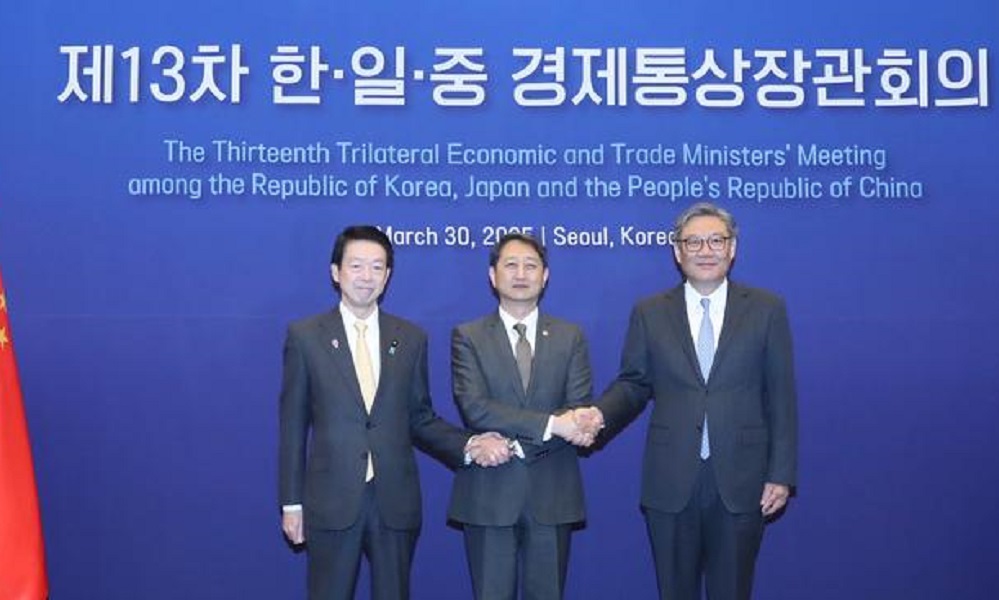
South Korea, China and Japan held their first economic dialogue in five years on Sunday, seeking to facilitate regional trade as the three Asian export powers brace from U.S. President Donald Trump’s tariffs.
The countries’ three trade ministers agreed to “closely cooperate for a comprehensive and high-level” talks on a South Korea-Japan-China free trade agreement deal to promote “regional and global trade”, according to a statement released after the meeting.
“It is necessary to strengthen the implementation of RCEP, in which all three countries have participated, and to create a framework for expanding trade cooperation among the three countries through Korea-China-Japan FTA negotiations,” said South Korean Trade Minister Ahn Duk-geun, referring to the Regional Comprehensive Economic Partnership.
The ministers met ahead of Trump’s announcement on Wednesday of more tariffs in what he calls “liberation day”, as he upends Washington’s trading partnerships.
Seoul, Beijing and Tokyo are major U.S. major trading partners, although they have been at loggerheads among themselves over issues including territorial disputes and Japan’s release of wastewater from the wrecked Fukushima nuclear power plant.
They have not made substantial progress on a trilateral free-trade deal since starting talks in 2012.
RCEP, which went into force in 2022, is a trade framework among 15 Asia-Pacific countries aimed at lowering trade barriers.
Trump announced 25% import tariffs on cars and auto parts last week, a move that may hurt companies, especially Asian automakers, which are among the largest vehicle exporters to the U.S.
After Mexico, South Korea is the world’s largest exporter of vehicles to the United States, followed by Japan, according to data from S&P.
The ministers agreed to hold their next ministerial meeting in Japan.
(Reuters)
World
Myanmar quake death toll hits 1,700 as aid scramble intensifies
India, China and Thailand are among Myanmar’s neighbours that have sent relief materials and teams, along with aid and personnel from Malaysia, Singapore and Russia.
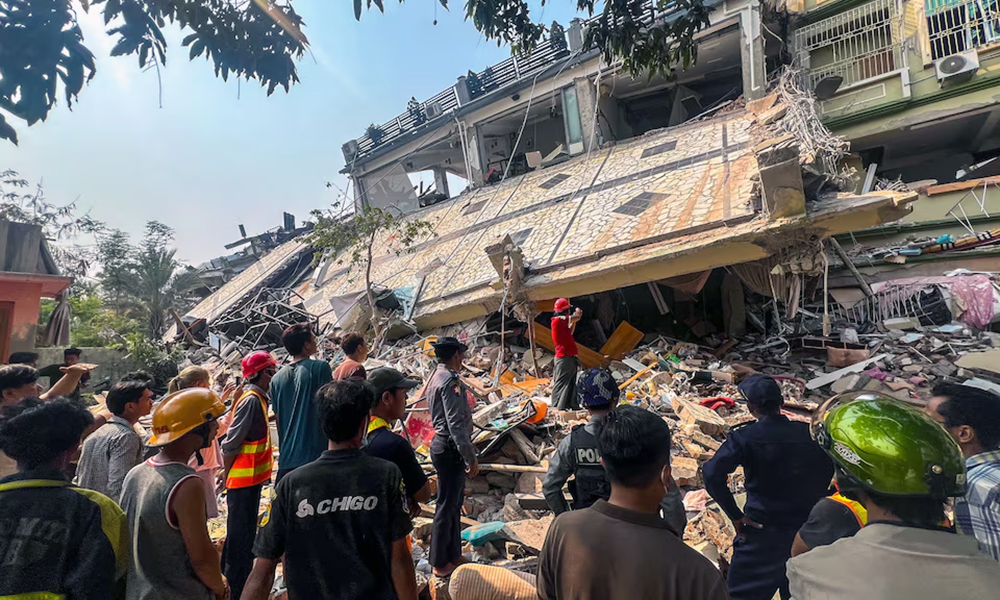
The toll from Myanmar’s earthquake continued to rise on Sunday, as foreign rescue teams and aid rushed into the impoverished country, where hospitals were overwhelmed and some communities scrambled to mount rescue efforts with limited resources.
The 7.7-magnitude quake, one of Myanmar’s strongest in a century, jolted the war-torn Southeast Asian nation on Friday, leaving around 1,700 people dead, 3,400 injured and over 300 missing as of Sunday, the military government said.
The junta chief, Senior General Min Aung Hlaing, warned that the number of fatalities could go up and his administration faced a challenging situation, state media reported, three days after he made a rare call for international assistance.
India, China and Thailand are among Myanmar’s neighbours that have sent relief materials and teams, along with aid and personnel from Malaysia, Singapore and Russia.
“The destruction has been extensive, and humanitarian needs are growing by the hour,” the International Federation of Red Cross and Red Crescent Societies said in a statement.
“With temperatures rising and the monsoon season approaching in just weeks, there is an urgent need to stabilise affected communities before secondary crises emerge.”
The devastation has piled more misery on Myanmar, already in chaos from a civil war that grew out of a nationwide uprising after a 2021 military coup ousted the elected government of Nobel Peace Prize laureate Aung San Suu Kyi.
Critical infrastructure – including bridges, highways, airports and railways – across the country of 55 million lie damaged, slowing humanitarian efforts while the conflict that has battered the economy, displaced over 3.5 million people and debilitated the health system rages on.
In some areas near the epicentre, residents told Reuters that government assistance was scarce, leaving people to fend for themselves.
“It is necessary to restore the transportation routes as soon as possible,” Min Aung Hlaing told officials on Saturday, according to state media. “It is necessary to fix the railways and also reopen the airports so that rescue operations would be more effective.”
The U.S. Geological Service’s predictive modelling estimated Myanmar’s death toll could top 10,000 and losses could exceed the country’s annual economic output.
Hospitals in parts of central and northwestern Myanmar, including the second-biggest city, Mandalay, and the capital Naypyitaw, were struggling to cope with an influx of injured people, the U.N. Office for the Coordination of Humanitarian Affairs said late on Saturday.
The quake also shook parts of neighbouring Thailand, bringing down an under-construction skyscraper and killing 18 people across the capital, according to Thai authorities.
At least 76 people remained trapped under the debris of the collapsed building, where rescue operations continued for a third day, using drones and sniffer dogs to hunt for survivors.
The opposition National Unity Government, which includes remnants of the previous administration, said anti-junta militias under its command would pause all offensive military actions for two weeks from Sunday.
The devastation in some areas of upper Myanmar, such as the town of Sagaing near the quake’s epicentre, was extensive, said resident Han Zin.
“What we are seeing here is widespread destruction – many buildings have collapsed into the ground,” he said by phone, adding that much of the town had been without electricity since the disaster hit and drinking water was running out.
“We have received no aid, and there are no rescue workers in sight.”
Sections of a major bridge connecting Sagaing to nearby Mandalay collapsed, satellite imagery showed, with spans of the colonial-era structure submerged in the Irrawaddy river.
“With bridges destroyed, even aid from Mandalay is struggling to get through,” Sagaing Federal Unit Hluttaw, a political association linked to the NUG, said on Facebook.
“Food and medicine are unavailable, and the rising number of casualties is overwhelming the small local hospital, which lacks the capacity to treat all the patients.”
In Mandalay, scores of people were feared trapped under collapsed buildings and most could not be reached or pulled out without heavy machinery, two humanitarian workers and two residents said.
“My teams in Mandalay are using work gloves, ropes and basic kits to dig and retrieve people,” said one of the humanitarian workers. Reuters is not naming them because of security concerns.
“There are countless trapped and still missing. The death toll is impossible to count at the moment due to the number trapped and unidentified, if alive.”
A video filmed by a Mandalay resident on Saturday and shared with Reuters showed patients in beds, some attached to drips, on the grounds outside a 500-bed orthopaedic hospital in the city.
Public and private health care facilities in Mandalay, including the Mandalay General Hospital and parts of Mandalay Medical University, were damaged by the quake, according to the World Health Organization.
Russian and Indian rescue workers were heading to Mandalay, and multiple teams of Chinese, Thai and Singapore rescue personnel have also arrived in the country.
In Bangkok, at the site of the collapsed 33-storey building, rescuers surrounded by shattered concrete piles and twisted metal continued their efforts to rescue dozens of workers trapped under the rubble.
Teerasak Thongmo, a Thai police commander, said his team of policemen and rescue dogs were racing against time to locate survivors, struggling to move around metal debris and sharp edges on an unstable structure.
“Right now, our team is trying to find anyone that might still be alive. Within the first 72 hours, we have to try and save those still alive,” he said.
Near the rescue operations, relatives and friends of the missing and trapped construction workers waited for news. Some broke down.
“Ploy, Ploy, Ploy, my daughter, I’m here for you now!” one woman wailed, as she was hugged by two others. “Ploy, can you hear me calling out for you?”
World
Myanmar quake death toll nears 700 as international aid starts to arrive
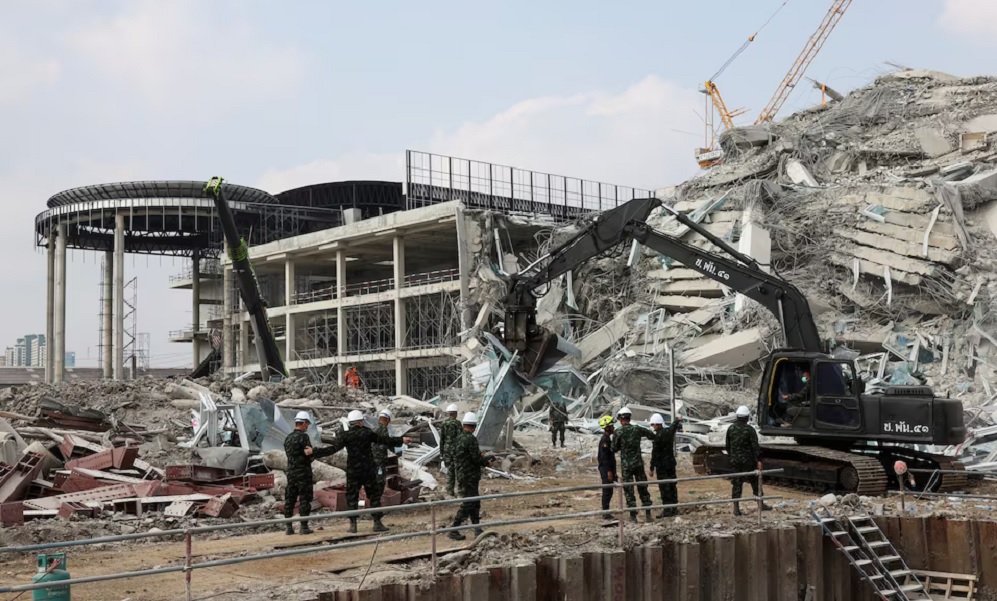
International aid began to arrive in Myanmar on Saturday as rescuers searched for survivors after a powerful earthquake devastated the Southeast Asian nation amid concerns the number killed would soar.
The death toll in Myanmar jumped to 694 with 1,670 injured, the military government said, up sharply from the 144 dead that state media reported on Friday, according to Reuters.
“Infrastructure such as roads, bridges, and buildings were affected, leading to casualties and injuries among civilians. Search and rescue operations are currently being carried out in the affected areas,” the junta said in a statement issued on state media.
The junta leader, General Min Aung Hlaing, had warned on Friday of more deaths and injuries as he invited “any country” to provide help and donations.
A Chinese rescue team arrived on Saturday while Russia and the U.S. offered aid in the disaster, which struck at lunchtime on Friday and damaged hundreds of buildings in neighbouring Thailand.
The United States Geological Service’s predictive modelling estimated the death toll could exceed 10,000 people in Myanmar, and that losses could be greater than the value of the country’s gross domestic product. Susan Hough, a scientist in the USGS’s Earthquake Hazards Program, told Reuters it was difficult to predict an earthquake’s death toll, for various reasons including timing. When an earthquake strikes during the daytime, as it did in Myanmar, “people are awake, they have their wits about them, they are better able to respond,” she said.
SEARCHING FOR WORKERS IN TOWER RUBBLE
Much of the devastation was in Myanmar’s second-largest city, Mandalay, close to the epicentre of the quake.
In the Thai capital Bangkok, 1,000 km (620 miles) from the epicentre a rescue mission was stepped up on Saturday to find construction workers trapped under the rubble of a collapsed 33-storey tower.
A 37-strong team from China landed in Yangon, Myanmar’s former capital, early on Saturday, carrying medicine and equipment to detect signs of life with them, the Chinese embassy said in a Facebook post.
Russia said it was sending 120 experienced rescuers as well as doctors and search dogs, state news agency TASS reported.
U.S. President Donald Trump said on Friday he had spoken with officials in Myanmar and that his administration would be providing some form of assistance.
Hough, who worked in Myanmar on the local seismology network, said the country’s mix of modern structures and traditional buildings would also play a role. Traditional buildings “are going to be less potentially deadly than concrete,” she said.
Thai authorities said nine people had died and 101 were missing in Bangkok, mostly labourers trapped in the rubble of the collapsed tower.
“We will do everything, we will not give up on saving lives, we will use all resources,” Bangkok Governor Chadchart Sittipunt said at the site on Saturday, as excavators moved debris and drones scoured the rubble searching for survivors.
The Thai capital ground to a halt on Friday and Chadchart said hundreds of people had spent the night in city parks, but he said the situation was improving.
-

 Latest News5 days ago
Latest News5 days agoAfghanistan has the right to access Amu River’s water: Uzbek minister
-

 Climate Change5 days ago
Climate Change5 days agoUN and ICRC warn of serious water shortage in Afghanistan
-

 Latest News4 days ago
Latest News4 days agoAmnesty international urges Pakistan to halt Afghan deportations
-

 International Sports5 days ago
International Sports5 days agoIPL 2025: Punjab Kings secure thrilling 11-run win over Gujurat Titans
-

 Latest News5 days ago
Latest News5 days agoUN ‘deeply disappointed’ over ongoing ban on girls’ secondary education
-

 Latest News4 days ago
Latest News4 days agoAfghanistan-Iran-Europe railway corridor activated
-

 Business4 days ago
Business4 days agoAfghanistan ships first consignment to Europe via Khaf-Herat railway
-
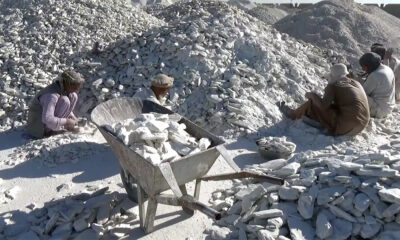
 Business3 days ago
Business3 days ago36 mining contracts inked over the past year: Mines ministry




